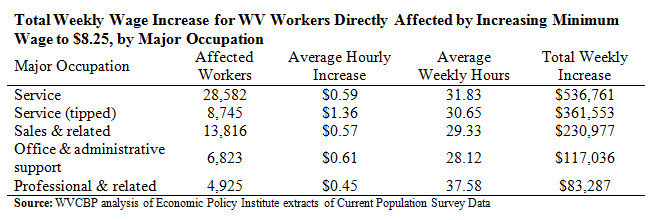When we last looked at the proposal to raise West Virginia’s minimum wage from $7.25 to $8.25 per hour, I showed that while West Virginia’s workers’ productivity was increasing, their wages weren’t, making it an ideal time to raise the minimum wage.
And while over 600 economists have joined together, stating that the weight of evidence shows that increases in the minimum wage have had little or no negative effect on the employment, there are still concerns that raising the minimum wage is too costly a burden for businesses to bear. But just how costly would West Virginia’s proposed increase be?
West Virginia’s proposal is to increase the minimum wage from $7.25 to $8.25, an increase of 13.8%. But that doesn’t mean that business costs will increase by 13.8%, nor does it mean that wages for affected workers will all increase by 13.8%.
Not all of the directly affected workers will see the full increase. On average, the directly affected workers earn $7.67 per hour, meaning that an increase to $8.25 will only be a 7.6% increase. For tipped workers, the minimum is likely to increase to $6.60 (80% of the regular minimum), whereas now, they average $5.24 per hour. Combine the increase with the average number of hours these workers work per week, and raising the minimum wage increases the weekly wages of the directly affected workers by $1.5 million.
How much is that in context? On the whole, employers pay out a total of $480.7 million in weekly wages.
So increasing the minimum wage to $8.25 would increase total labor wage costs in the state by only 0.3%.
Now a 0.3% increase in labor wage costs seems unlikely to result in significant job loss or price increases, but that figure is across all industries. What about those with a lot of minimum wage workers? Is the cost much higher? This next table shows the number of workers directly affected and total weekly cost of the increase by major occupation. Altogether, these industries account for 88% of the total number of directly affected workers. As the table shows, the service industry sees the biggest impact, a total of 37,000, with over half of all the workers directly affected, raising their weekly wage costs by nearly $900,000.
 But again, let’s put those numbers into context, and look at total weekly wages paid in these industries.
But again, let’s put those numbers into context, and look at total weekly wages paid in these industries.
 And an increase in the minimum wage would increase weekly wage costs in each industry by…
And an increase in the minimum wage would increase weekly wage costs in each industry by…
More than half of the workers affected by a minimum wage increase are found in the service sector. And more than a third of the workers in the service sector would see a raise. But even then, the total weekly wage cost in the industry would only go up by 1.8% if the minimum wage is increased to $8.25.
With the relatively minor cost of increasing the minimum wage, coupled with the savings from reductions in turnover and retention costs, it shouldn’t be a surprise that increasing the minimum wage doesn’t really hurt the economy. Instead, it puts money in the pockets of those who need it most.